The Odyssey
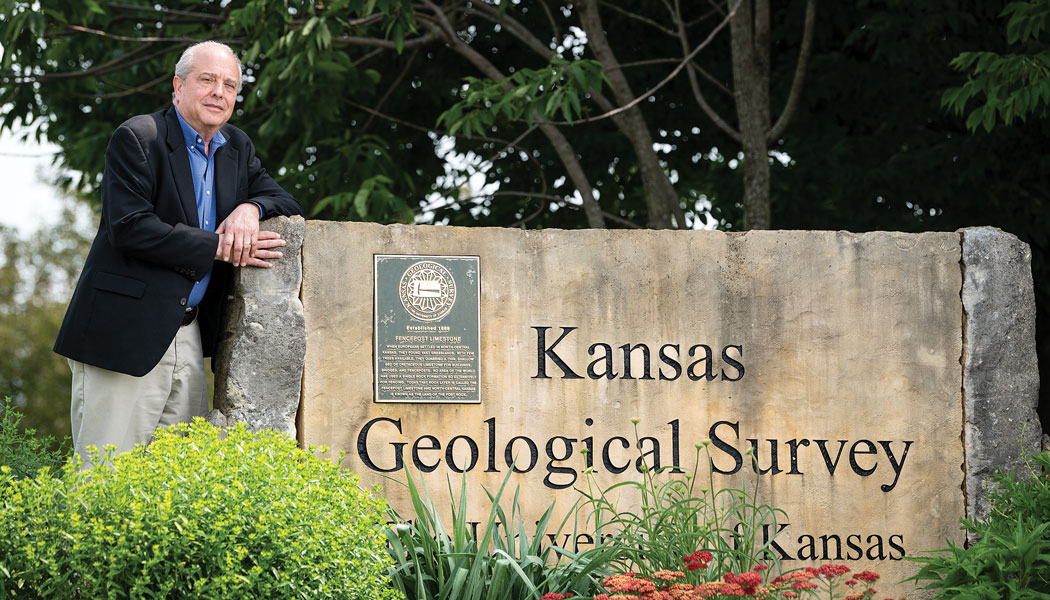
niversity Distinguished Professor Rolfe Mandel hunts history, old history, older even than ancient history. Prehistory, the good stuff, the mystery history. Deep soils, deep digs, deeper still, and suddenly you’re way back in time and the hunt is on.
“Deep,” Mandel explains. “The earliest. Deep time.”
Mandel’s hunt, his quest, his odyssey, is to find evidence of the earliest humans on the central Great Plains. Before the 1990s, scholars generally agreed that the so-called Clovis people were the first humans to roam North America, perhaps as early as 13,500 years ago. Recent finds have pushed that number back: Mandel is particularly intrigued by Paisley Caves, in Oregon, and a pair of sites in southern Wisconsin, known as Schaefer and Hebior, all of which seemingly present evidence of human activity about 14,500 years ago.
Although his fieldwork takes him to sites as far-flung as Cyprus, Jordan and Egypt, the heart of Mandel’s research has always been, and remains, the middle of North America.
Along with his retinue of graduate students and postdoctoral researchers, Mandel, g’80, PhD’91, has for nearly 20 years embarked on his adventures thanks to the unlikeliest of partners, a Denver geologist and investor who, in the words of Dale Seuferling, president of KU Endowment, appeared “out of the blue” to offer a million-dollar gift.
“It is well known that research for identification of the first Americans,” Joseph L. Cramer wrote in his 2002 introductory letter, as quoted in the Spring 2019 issue of the Endowment magazine, KU Giving, “constitutes the great mystery of the New World.”
What neither Mandel nor Seuferling knew at the time was that Cramer’s generous gift, which launched and funded the Odyssey Archaeological Research Fund for more than 15 years, would one day blossom beyond their wildest dreams.
The hunt was on.
Rolfe Mandel grew up in San Antonio. He studied physical geography—earth surface processes—at the University of Texas in Austin. After graduating with honors, Mandel was stunned when his adviser and mentor, Curt Sorenson, departed for the geography department at KU. The following year, 1976, Mandel joined him in Lawrence.
“Kansas seemed like a faraway place,” Mandel says. “I grew up in Texas. I had a lot of close ties in Texas. But, Curt managed to pry me loose from Texas.”
Here Mandel continued to study soils, landscape evolution and climate change, and after earning his master’s, in 1980, he chose to step away from the usual track for academic stars and join a research institute for environmental and public policy based in Blake Hall. Energized by the challenging work, Mandel in the late 1980s rejoined the KU graduate program, within the rare designation of “special studies,” which allowed him to piece together an extraordinarily unusual PhD committee.
“It was not easy to do,” he says. “They make it very difficult, because they don’t want anybody doing an end run to make it easier. So they make it just the opposite: as difficult as possible. But, because I considered myself multidisciplinary, that allowed me to put together a very diverse committee, with geology, geography, paleontology and soils. I even got a faculty member from K-State on my committee.”
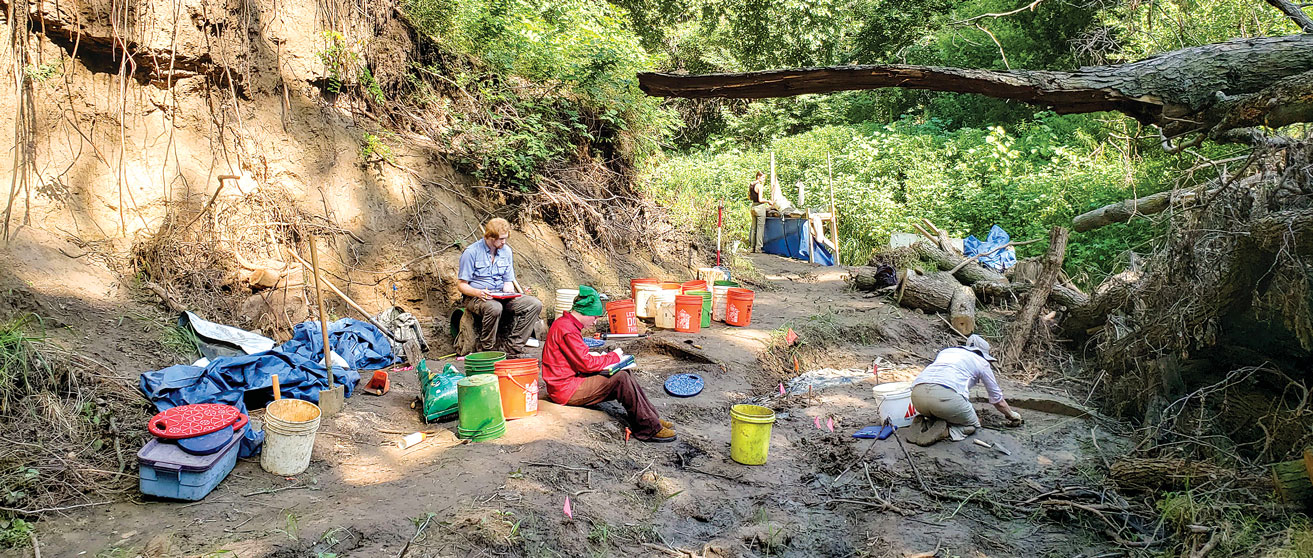
The earth, weather and soils processes that became focal points of Mandel’s research are intensely complex, yet can still be grasped by budding archaeologists who hunted arrowheads by identifying topographical features—creeks or pleasant meadows, for instance—that would have enticed people of any era to hunt, fish and camp. Yes, Mandel explains patiently, that’s a first step, but it lacks the crucial element for investigations into deep human history to offer meaningful results: context, and context only happens when the evidence is found in situ, or buried and preserved in place.
Over the past 10,000 years, since the last ice age, wind-blown sediments in North America’s northern Plains were washed downstream, into the central Plains, becoming especially thick in stream valleys. What eroded above ended up below. The end of the last ice age also brought on large-scale change in weather patterns across the central continent as the jet stream drifted up from what is now northeastern Texas. Although the central Plains became drier overall, they were also subjected to the same sort of massive storms that this year soaked Kansas and the entire Midwest.
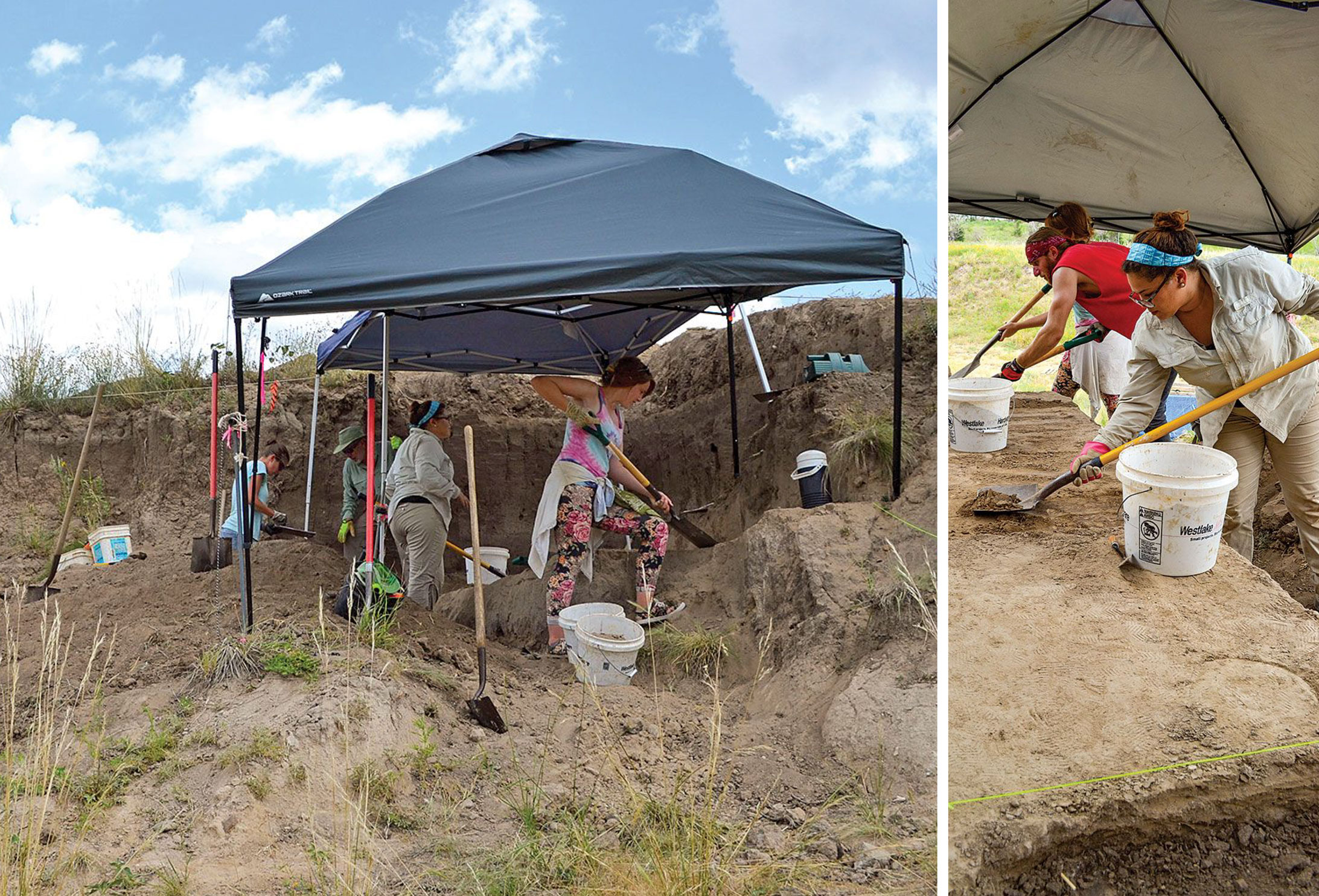
The onset of infrequent large storms and associated accumulation of sediment conspired to bury the archaeological record. As Mandel explained in a landmark 2008 paper published in the journal Geomorphology, a relative abundance of early sites found in other areas of the Great Plains and along the eastern Rockies, and the apparent paucity of 13,000-year-old Clovis sites in the central Plains, do not necessarily mean early humans weren’t here. Mandel concluded evidence of their likely existence in the central Plains got buried.
Deep.
“It’s like a giant jigsaw puzzle with most of the pieces missing,” says Art Bettis, professor emeritus at the University of Iowa and a longtime friend and colleague of Mandel’s, “and you’ve got to find those little pieces that are still out there somewhere and try to piece them together. Rolfe is really good at it. That’s what he does.”
Buried jigsaw puzzle pieces, that’s the bad news. The good news is that when unearthed from a sealed, stratified site— “a layer cake of occupation,” Mandel explains—stone projectile points and scrapers, charcoal, hearths and megafauna bones with human-inflicted marks can be definitively studied and analyzed.
“What makes Rolfe distinct within the geoarchaeological community,” says Jared Beeton, PhD’07, assistant professor of environmental studies at Fort Lewis College in Durango, Colorado, and the Odyssey program’s first graduate student, “is that he’s a specialist in soils and paleoenvironments. That’s exactly what’s needed to answer the question of, who are the first North Americans? A lot of times we don’t even know what we’re looking for, and there’s not a lot of material artifacts out there. It’s more about figuring out what the environment was like and trying to piece together the story from soils.”
Sometime around 2000, Mandel was intrigued by an opportunity at the University of Arizona and applied. He didn’t get the job, but did meet the private donor who funded Arizona’s new position: Denver oil and gas wildcatter Joe Cramer, a multimillionaire who lived with his wife, Ruth, in a modest home and drove an old car and was consumed by what Mandel describes as “a curiosity about who was here before us.”
During the interview process, Mandel and Cramer clicked, and Mandel invited the ornery, opinionated, intelligent enthusiast to visit a KU dig underway in northwestern Kansas. Cramer accepted, and became a fan of Mandel’s techniques and ideas.
Cramer was then in the midst of establishing a network of research programs with $1 million endowments to six universities; KU made the cut when another prominent university in a neighboring state would not agree to Cramer’s conditions for how his endowment would be administered.
“Bottom line was, I literally got a call from Joe and he said, ‘Rolfe, I want to give you $1 million.’ That was the phone call. I said, ‘Joe, small, unmarked bills in a paper sack.’ He thought that was pretty funny.”
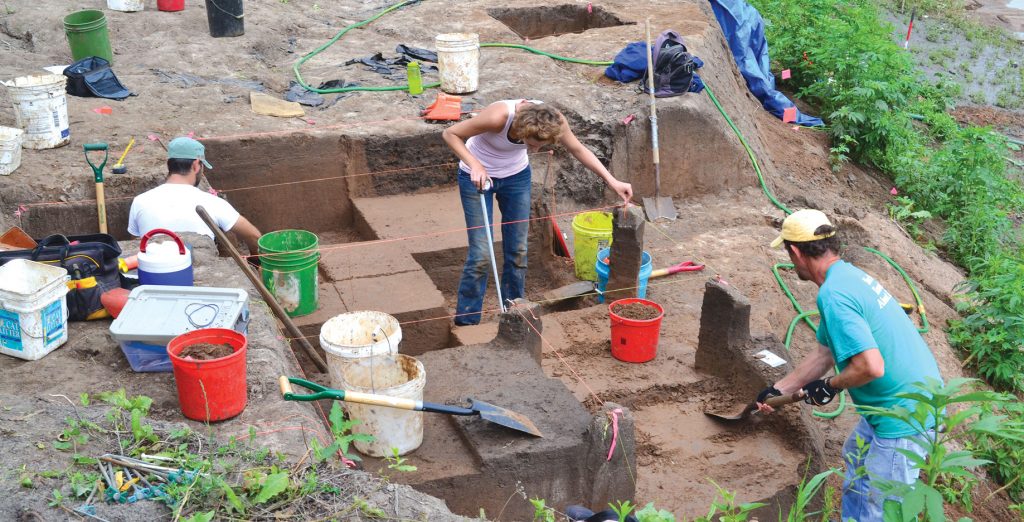
Of the six original programs, Cramer eventually chose three universities to share the bounty of his family trust: KU, Texas A&M and Nevada-Reno, each with a focus in different areas of the country. When Mandel and Cramer first discussed the possibility of KU sharing in the trust, Mandel was led to believe that, if it should happen at all, it would be about $2 million, maybe a bit more. “And I was never even certain that he established it,” Mandel says.
Joe Cramer died in 2013, followed by Ruth in 2018. Mandel, who in 2017 was named director of Kansas Geological Survey, where Odyssey is housed, finally learned in late 2018 that KU had, in fact, been included in the trust. The good news got even better: Thanks to wise investments, KU’s share would be worth $6.9 million, bringing the Cramers’ total KU gift to nearly $8 million—from a family with no connections to Mount Oread other than a shared passion for discovery.
When Cramer first met with Seuferling, j’77, and Mandel to discuss the possibility of a trust gift, Cramer had in mind an endowed chair that would focus on the search for the earliest people in the Americas. But, Mandel says, “I actually talked him out of it.”
Instead of investing the entire gift in one person, Mandel argued, it should instead be used to pay postdoctoral fellows and graduate students, especially since one of Joe and Ruth Cramer’s stated goals was to train the next generation of researchers in fieldwork and laboratory analysis so they could then train further generations, an endless wave assuring that the Cramers’ money would fuel the hunt for early North Americans far into the future.
“As graduate students we would talk about that a lot over beers at the end of the day, about how lucky we were to be able to just do our research and have all that funded,” Beeton says. “A lot of students will spend hours doing other jobs while they’re PhD students. For us—at least for me—I didn’t have that. I was paid to do my own work, which is really cool.”
Along with the money, KU also received the entirety of Joe Cramer’s massive library—30 four-drawer file cabinets—of books, maps, scientific papers, news clippings and geology and archaeology ephemera, and another cabinet containing a catalog of thousands of meticulous index cards typed by Cramer himself. Note, too, that the geoarchaeology research the Cramers funded is called the Odyssey program, not the Cramer Odyssey program.
“Joe did not want his name attached to it,” Mandel says. “He saw that as a distraction.”
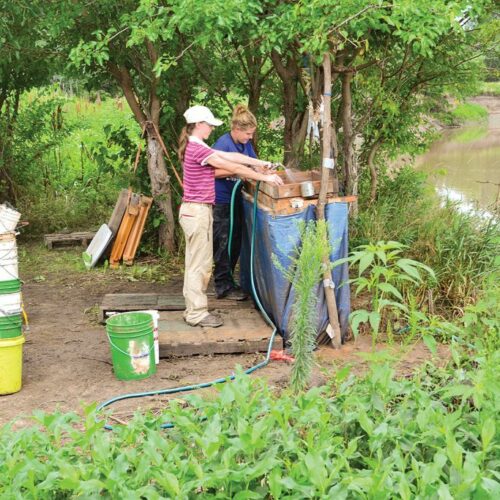
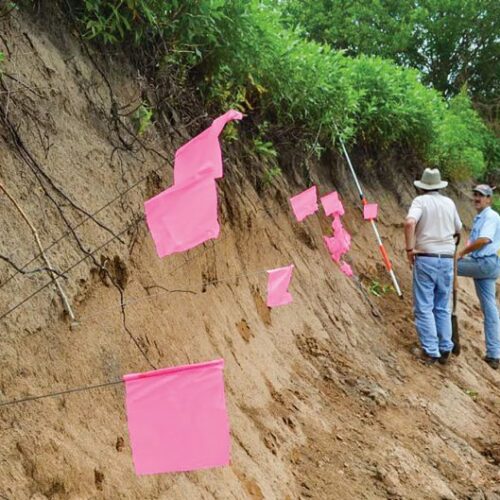
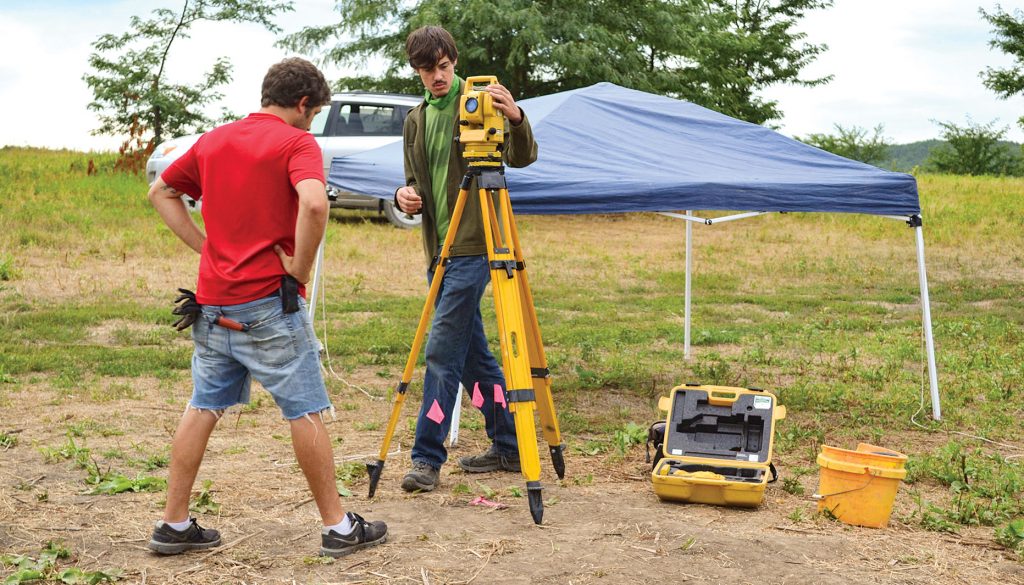
Mandel intends to direct the program for the rest of his career and one day retire knowing that Odyssey will thrive in perpetuity off the gift’s interest alone.
“This gives us a means to try to recruit, literally recruit, the best graduate students,” Mandel says, “and then hopefully this is a jumping off point for their careers and they’ll continue the search, so it won’t just end here.”
Although Cramer stipulated that research he funded at KU focus on the central Great Plains, the terms did allow for some broader excursions: Mandel and colleagues, including ancient-DNA specialist Dennis O’Rourke, Foundation Distinguished Professor, this summer will fly into the Canadian Yukon to inspect an intriguing site known as Bluefish Caves, where investigations by French-Canadian researchers in the 1970s hinted at possible evidence of the earliest known humans to have crossed the Beringian land bridge during low ice-age seas.
“There’s a series of rock shelters, not really what I call a cave, that have evidence of human occupation 21,000 to 25,000 years ago,” Mandel says. “This would have been the type of site that Joe would just relish having somebody go in and look closer.”
To reach the site, the KU Odyssey investigators will fly by helicopter into a remote area of the Yukon near the village of Old Crow. Mandel designed this summer’s trip as a reconnaissance expedition; if they find hints of what they’re looking for, Mandel plans to return in summer 2020.
“This is an expensive trip,” he says, “and Odyssey gives us the opportunity to do it.”
Joe Cramer, Mandel explains, was well aware of funding pressures facing university scientists, especially those who are not, for instance, curing cancer.
“I still remember Joe saying, ‘The luxury of this is that you don’t have to spend all your time hustling money. You can actually go out, hit the ground running, and search.’ He’s right. This was his way of freeing us from that burden. And, you never know. You can invest a lot of time in a proposal and not get funded. He said, specifically, ‘This is your opportunity to not have to do that.’”
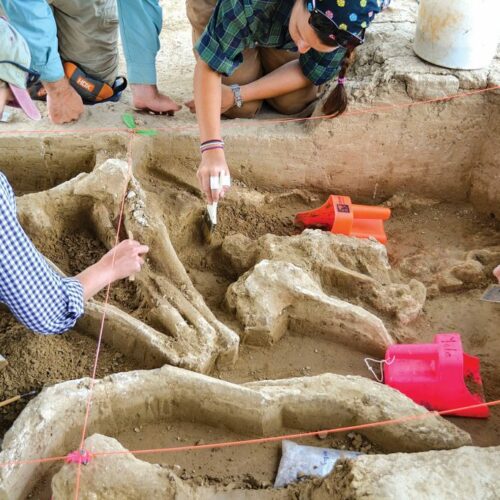
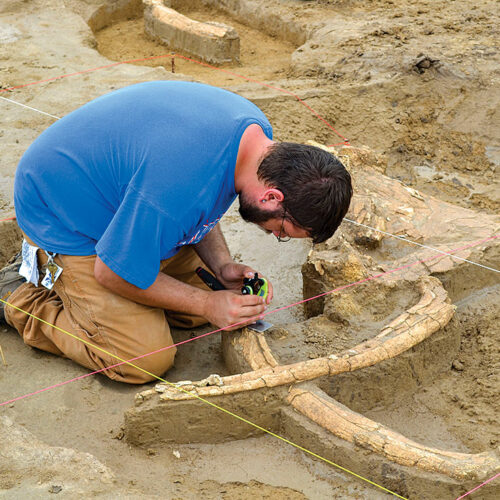

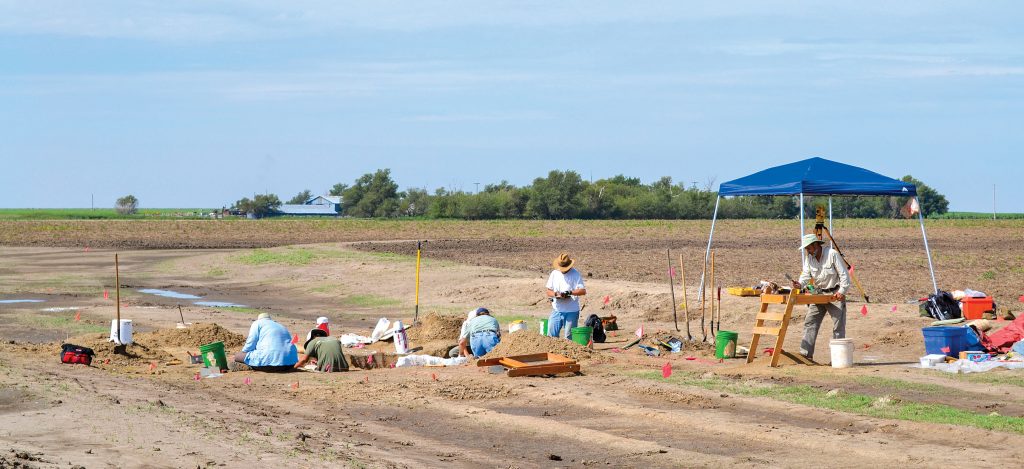
Mandel in summer 2017 invited Kansas Alumni to visit an Odyssey dig in the Mark Twain National Forest, on the Current River in Missouri’s southeastern Ozarks. As promised, at 8 a.m. on July 17, Mandel can be found sorting gear in the back of his big Silverado pickup, in the parking lot of The Landing, a sprawling motel complex that’s a mecca for floaters and kayakers.
The morning weather promptly transitions from warm to hot, muggy and buggy, but at least it is dry. Here, dry is good, ever since May 2, 2017, when 12 inches of rain turned the pleasant Current into a monster that swept through and over the nearby town of Van Buren. The Landing sits high above the Current, but not high enough; the surging river swamped the beautiful main building and its restaurant. Now, nearly two months since Van Buren almost got wiped off the map, The Landing’s restaurant remains closed. No breakfast here. Change in plans.
“The only place open is McDonald’s,” Mandel says with a shrug. A highway McDonald’s it is. Except, it isn’t. Serving breakfast, that is. No power, the sign says. The Sinclair filling station and Subway sandwich shop next door are dark, too.
Last option: a convenience store in town. Mandel is in Van Buren for one day, a fast visit to the site up in the neighboring mountains being worked by his KU Odyssey students and students from Missouri State University. He is eager to find a bite to eat before heading out for a long, hot day in the field, but nobody else in Smalley’s Convenience and Deli appears to be in much of a rush.
The parking lot is full. Young men loll about out on the porch, smoking cigarettes and drinking Mountain Dew; inside, old men crowd a long table, sipping coffee and chatting. The short-order grill bustles, and a few families wait patiently for scrambled eggs, waffles and Texas toast.
Smalley’s is crowded because it survived. It was high enough up the hill from the heart of downtown Van Buren to escape the four-story-high waters that destroyed churches, businesses and schools. If the locals are tired of talking about that damn flood, on this morning they can bat around a new topic of conversation: The Current Local newspaper, 75 cents each over by the cash register, features a well-reported story about a fossils dig launched by the guy enjoying his ham-and-egg biscuit at the next table over.
First people of the Ozarks: Archeologists dig for ‘pre-Clovis’ clues at Big Spring
The site being investigated by Mandel and Jack Ray, an MSU research archaeologist, abuts an abandoned Depression-era shower house built by the Civilian Conservation Corps. When utility-line trenches were dug in the 1970s, stone projectile points were uncovered. The limousine-sized pit—as it was aptly described by a student digger—attracts wandering visitors throughout the 98-degree day, including a retiree who says he’s been finding arrowheads around here since he was a boy. With the Western Hemisphere’s largest single-vent spring—the otherworldly beautiful and serene Big Spring—just around a bluff, the locale was, and is, in Mandel’s words, “an oasis.”
It clearly attracted roaming bands of hunters and their families, who must have enjoyed Spring Valley for the same reasons that attract visitors today. As the KU and MSU students had already confirmed in 26 previous days of digging, 10,000-year-old artifacts, including points carved from stone sourced from St. Louis to Arkansas, had been sealed in situ.
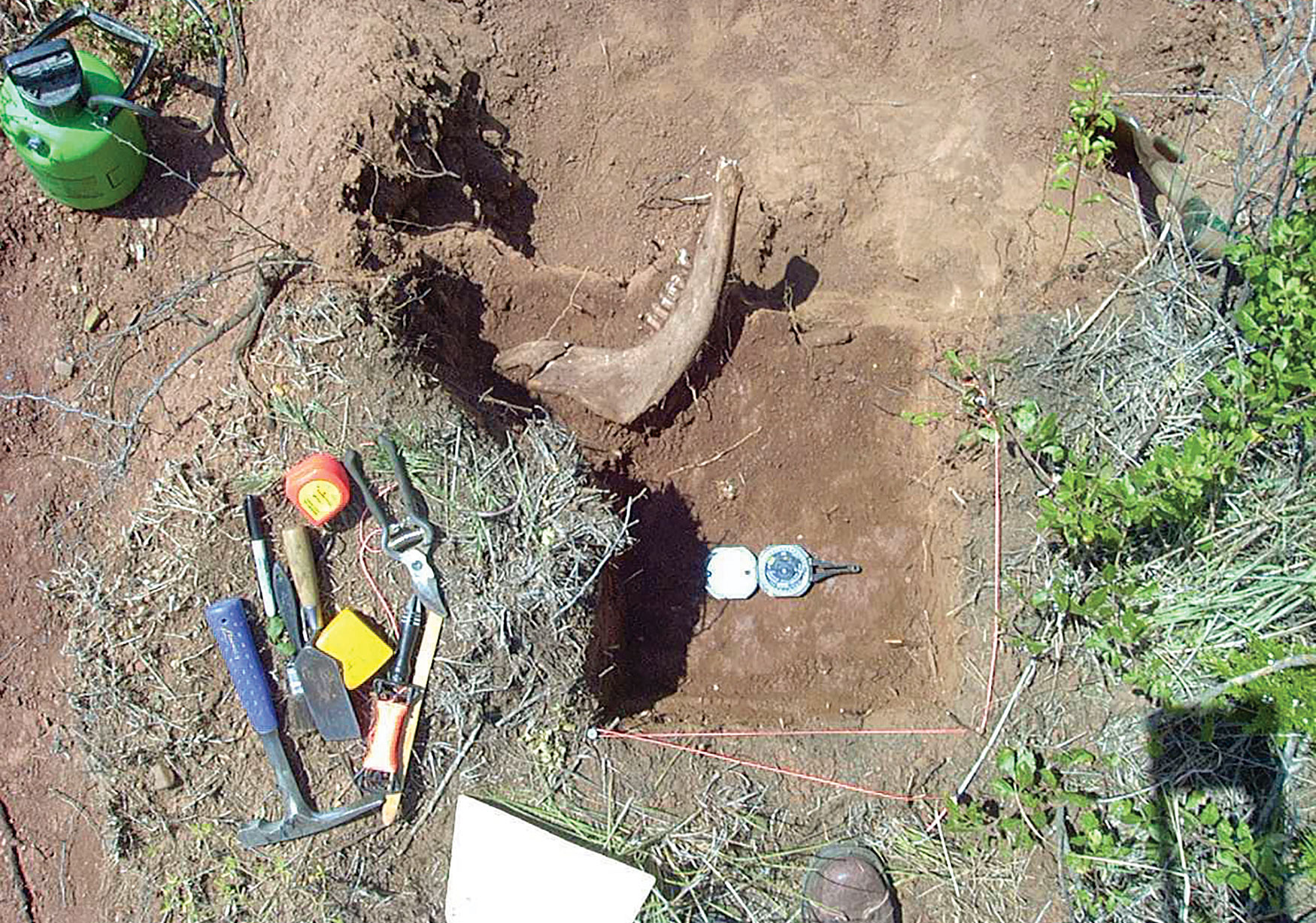
Yet the question remained: Might they find anything older? Encouraged by the results, Mandel approved funding for another five days of digging, sifting and sorting. The search ultimately proved futile, but only in the context of uncovering stratified evidence of pre-Clovis occupation. It will still be an important Dalton-era—or late Paleo-Indian—site, worthy of further research by scientists at Missouri State University and the National Park Service.
“We wanted to see if there was something earlier, early paleo, and unfortunately the deeper we went the sediments just basically disappeared and we got right down onto rock,” Mandel later explains. “Nothing ventured, nothing gained, right? My philosophy is, it doesn’t matter if you find it or not. You’ve got to look.”
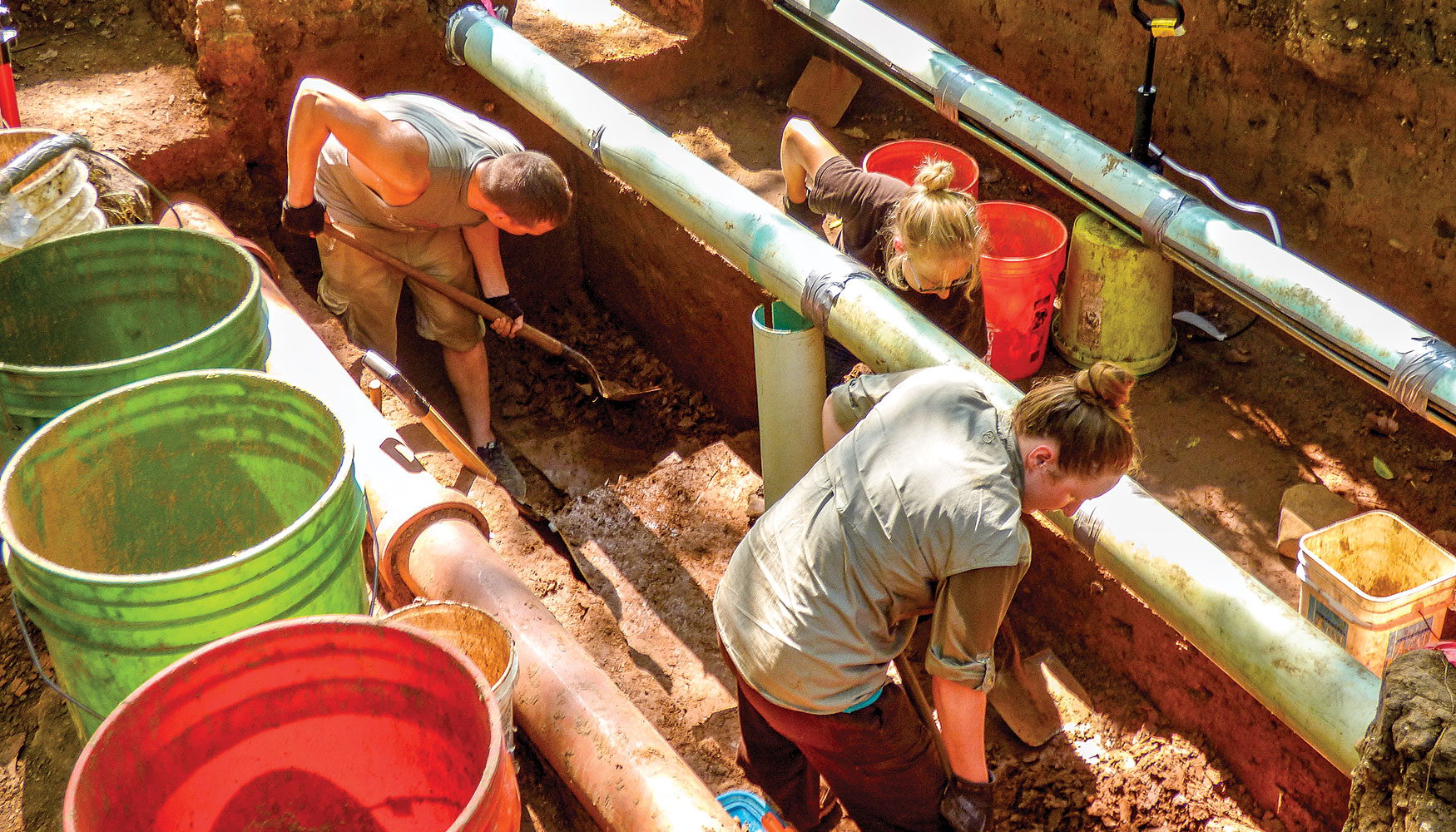
Up top we stated that Mandel’s quest is to find evidence of the earliest people on the central Plains. Turns out, that is not precisely accurate.
“He’d love to do it,” Bettis says from his Iowa home. “Who wouldn’t? But it’s not what drives him. I think it’s understanding the situation that drives him.”
Here’s the way Bettis sees it: Mandel is “so modest” that personal glory is not a factor. This is a guy, after all, who convinced an eager donor not to create an endowed chair. Instead, Bettis says, Mandel hopes his decades of sweat and scholarship improve the chances that the person who does make the next big find—maybe even one of his Odyssey descendants—does it right.
“He’s set the stage so when that discovery is made, it will be made in the proper way,” Bettis says. “It’s the geologic context that’s important. You’ve got to be able to demonstrate it on the basis of the deposits. You can’t find a point type, you can’t determine a radiocarbon age, without the context. It’s going to have to be the geology of the site, of the location, that actually makes it solid.
“I think he’s well aware of that, and that’s what he’s doing. He’s laid the framework for whoever happens to make that discovery. And, who knows what the earliest one is out there anyway? I think that’s a moving target.”
Sic transit gloria mundi, eh? Why should busy scientists like Mandel and Bettis let themselves get consumed chasing the glory of a find that one day will almost certainly be eclipsed?
It is enough that Mandel’s seminal 2008 paper detailing landscape evolution in the central Plains fundamentally altered the search for early Plains people. No longer would it be acceptable to simply rely on happenstance—sites uncovered during highway construction, for instance. Instead, the search requires an understanding of the land itself, the very soil from which discoveries would be exhumed.

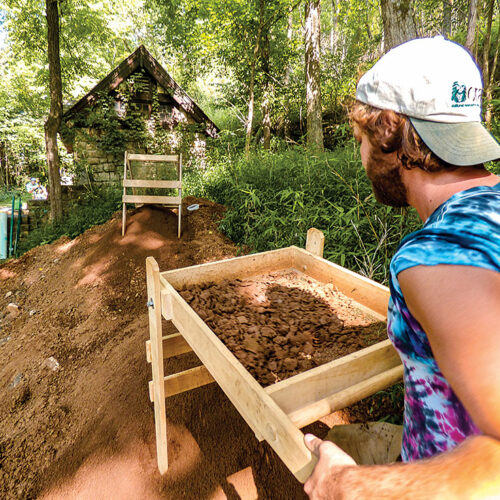
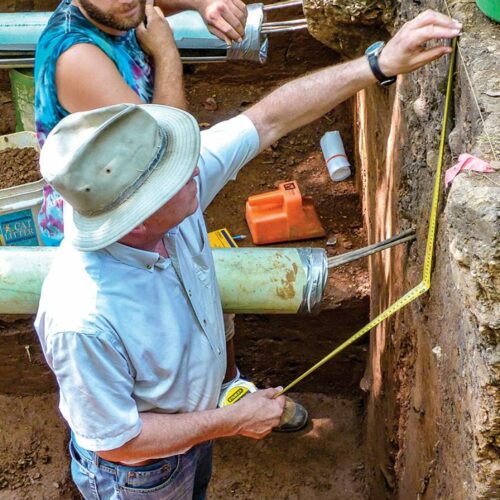
As with Claussen, the Spring Valley dig in the Missouri Ozarks revealed ample evidence of Dalton-era occupation; unlike Claussen, there’s no hope of finding anything older because the 2017 Odyssey dig reached bedrock. “It was the ideal place,” Mandel says. “The problem was, the age of the sediments kind of petered out at the bottom.”
CHRIS LAZZARINO
In awarding Mandel the 2010 Kirk Bryan Award for Excellence, the Geological Society of America described the science contained in Mandel’s “great, influential paper” as “actually quite staggering.” One table alone contains geoarchaeological analysis of dozens of Great Plains sites. “You’re looking at my career, practically,” Mandel says. “It took me 20 years to do that.”
What Mandel has done, in his writing and research and teaching and mentoring, is convince hopeful time travelers to read the earth. The best way to find needles on a continent of haystacks is to understand how the haystacks were arranged eons ago.
“This whole idea that Rolfe got involved in, looking at all of prehistory over a really big area, that was totally brand new,” Bettis explains. “Nobody ever did that. And now, that’s sort of the way people do it. It’s really caused a big revolution.”
Mandel recalls accompanying an archaeologist to a potential site in the Elkhorn River Valley, in Nebraska. Mandel took in the lay of the land and eventually said, dig here. Sure enough, 10 feet down, they found a huge, 6,000-year-old hearth.
“The archaeologist was looking at me like, ‘How did that happen?’ But it’s not like it was magic. It’s because I knew the landscape. I knew this was a place where people lived because I understand the landscape and I understood the processes that would bury a site in this setting.
“It’s not luck. It’s not fortuitous. It’s understanding the landscape, and that’s my wheelhouse.”
When Mandel approaches land owners to ask permission to visit their property, he’s often met with grim, skeptical faces. Then he explains what he thinks might be buried under the soil these people thought they knew so well.
“Whenever you start talking to them about deep history, they perk up and want to hear about it. ‘Windows into the past’ is the way I like to look at it. You actually have physical remains, and then it’s not just a story.
“You have something that you can hold in your hand, and I think we all find that a little bit enchanting.”
Dig deep. Deeper still. And, eventually, time will travel back to us.